In the dynamic world of startups, Software as a Service (SaaS) businesses have emerged as a dominant force. Their subscription-based model offers users the latest updates and features, ensuring an ever-evolving user experience. But as with any industry characterized by rapid growth and fierce competition, standing out can be a herculean challenge.
This is where the magic of Search Engine Optimization (SEO) comes in. Tailored SEO strategies don’t just help in enhancing online visibility but can effectively guide potential customers through the buying journey. For SaaS companies, this journey can be distinct and requires a specialized approach.
In this comprehensive guide, we’ll navigate through the intricate maze of SaaS SEO, offering insights, strategies, and real-life case studies to illustrate the transformative power of SEO for software businesses.
Understanding the SaaS User Journey
SEO isn’t just about getting visitors to your site; it’s about guiding them once they’re there. The path a user takes from initial interaction to final conversion can be considered their ‘user journey’, and for SaaS companies, this journey possesses its unique quirks.
Differences between Traditional and SaaS Customer Funnels
Traditional customer funnels often follow a linear path: Awareness, Interest, Desire, and Action. SaaS funnels, however, are nuanced. Due to the software’s evolving nature and periodic billing, there’s a heightened focus on retention, making the post-purchase phase crucial.
Apart from acquiring customers, there’s an equal, if not more, emphasis on reducing churn and upselling.
Tailoring SEO for Awareness, Consideration, and Decision Stages of SaaS Buyers
Awareness involves attracting prospects who might not even be aware they need your software. Content here should educate about problems your software solves. As prospects move to the consideration stage, they’re comparing options. SEO strategies should highlight unique features, integrations, or USPs. Lastly, in the decision phase, potential users might be looking for reviews, case studies, or trials. SEO efforts here should be about building trust and reducing friction to conversion.
Case Study: ‘Zoom’ – Mapping and Leveraging the User Journey for Growth
Zoom’s meteoric rise wasn’t just due to its impeccable timing but also its astute understanding of the user journey. During the awareness stage, Zoom targeted keywords related to seamless video communication, capitalizing on the remote work trend.
Their content hubs, blog posts, and webinars catered to those considering multiple virtual communication tools.
By the decision phase, Zoom made sure to emphasize its integrations, security features, and glowing user reviews. SEO played a pivotal role in guiding users from curiosity to loyal customer.

Keyword Research: Beyond Generic Software Terms
In the SaaS realm, the competition is not just intense; it’s staggering. With thousands of software products jostling for visibility in the digital ecosystem, differentiating your offering becomes mission-critical. Traditional SEO keyword tactics, which hinge on generic software terms, won’t cut it.
To break through the digital noise, you must venture beyond the ordinary and understand the specific needs and pain points of your potential users.
Tools and Techniques: Gearing Up for Precise Keyword Research
To ensure your SEO efforts bear fruit, you need a thorough understanding of your target audience. With tools like SEMrush, Ahrefs, and AnswerThePublic, the process becomes less about guessing and more about precision.
SEMrush enables a deep dive into your competition’s keyword strategy. By analyzing their most valuable keywords, you can identify gaps in your own content. Additionally, it allows you to uncover long-tail keywords that might have less competition but hold significant potential for driving quality traffic.
Ahrefs, on the other hand, is a powerhouse for backlink and keyword research. Its keyword explorer feature provides essential metrics like keyword difficulty, search volume, and even clicks data. For SaaS companies, this is a goldmine as it reveals the terms driving traffic to similar software products.
AnswerThePublic shifts the focus from what’s being searched to understanding why it’s being searched. By visualizing search questions and prepositions related to your seed keyword, it uncovers user intent. This is especially valuable for SaaS products, as understanding the problems your software solves can directly inform your content strategy.
The Essence of Problem-Solving Keywords and Pain-Point Queries
Put yourself in the shoes of a potential user. They’re not searching for “CRM software” just for fun; they’re likely facing challenges with customer management, seeking more efficient sales processes, or needing better data analytics. These are pain points, and by addressing them, you not only capture traffic but also build trust.
For instance, if your SaaS solution is an email marketing tool, your users might struggle with “increasing email open rates” or “automating email campaigns.” Crafting content around these pain-point queries provides immediate value to the user and positions your SaaS as a solution.
User Intent: The Cornerstone of SaaS Keyword Strategy
In the world of SaaS SEO, recognizing user intent isn’t just crucial; it’s transformative. Generic keywords might get you traffic, but without aligning to intent, conversions will remain elusive. There are primarily three types of search intent:
- Informational: The user seeks knowledge. E.g., “How does cloud storage work?”
- Navigational: The user aims to visit a particular site. E.g., “Dropbox login.”
- Transactional: The user wants to purchase or use a service. E.g., “Best cloud storage for businesses.”
For SaaS platforms, this understanding is pivotal. If a user searches “benefits of CRM software,” your content should be informational, educating the user about CRMs. If they search for “CRM software pricing,” they’re likely in a transactional mindset, and your landing page should guide them towards a free trial or a demo.
Case Study: ‘Asana’ – The Art of SEO Dominance through Targeting Productivity Pain Points
Asana, the productivity and task management tool, is an exemplar of a SaaS company wielding SEO with precision. Instead of only targeting terms like “task management tool” or “project management software,” Asana delves deeper into the user’s psyche.
Understanding that businesses often grapple with “improving team collaboration” or “efficient task delegation,” Asana crafted content that speaks directly to these challenges. By doing so, they didn’t just improve their search rankings; they provided value. When a manager, overwhelmed with juggling multiple projects, searches for solutions to streamline operations and stumbles upon an Asana article offering actionable insights, the brand’s credibility skyrockets.
Furthermore, Asana capitalized on long-tail keywords, often questions, that users were asking. “How to keep track of team tasks” or “ways to improve project visibility” became focal points, leading users straight into Asana’s funnel.
To sum up this section, while tools like SEMrush and Ahrefs offer the mechanics of keyword research, the soul lies in understanding user pain points and intent. As seen with Asana, aligning with these can lead to SEO dominance.

Content Creation: Educating and Convincing Prospects
Engaging content is the backbone of a stellar SEO strategy, especially for SaaS companies. Beyond drawing users to your website, content has the power to educate, convince, and even transform the perception of your brand.
Crafting Content that Addresses Pain Points, Offers Solutions, and Showcases Unique Selling Propositions (USPs)
For SaaS startups, content shouldn’t just be about product features. It should resonate with the challenges users face daily. By addressing specific problems and showcasing how the software offers a solution, brands can position themselves as indispensable allies in their users’ journeys. Moreover, in a saturated market, highlighting USPs—whether that’s unrivaled customer support, unique integrations, or groundbreaking features—can set a company apart.
The Potential of Webinars, Tutorials, and Detailed Guides
Considering the often intricate nature of software solutions, video content like webinars and tutorials can be game-changers. These not only offer users a more digestible way to understand the product but also showcase the brand’s commitment to customer success. Detailed guides, on the other hand, cater to users who prefer in-depth, step-by-step walkthroughs.
Leveraging User-generated Content: Reviews, Testimonials, and Forums
Nothing convinces prospects more than hearing positive feedback from fellow users. Authentic reviews and testimonials can act as social proof, significantly boosting conversion rates. Encouraging discussions on forums can also provide invaluable feedback while simultaneously driving engagement and brand loyalty.
Case Study: ‘HubSpot’ – Establishing Industry Authority through Inbound Content
HubSpot’s approach to content is textbook perfection. The company has positioned itself as an industry thought leader through its exhaustive library of guides, courses, and webinars. They’ve harnessed the power of inbound marketing to its fullest, attracting prospects by providing immense upfront value.
From educating readers about the nuances of inbound marketing to offering tools and templates to facilitate it, HubSpot’s content strategy is both generous and genius.

Technical SEO: Ensuring Flawless User Experience
In today’s digital age, where SaaS startups face fierce competition, it’s not enough to just have a great software solution. The way your potential users perceive and experience your platform online plays a critical role in driving conversions and retaining customers. Enter the domain of Technical SEO, a crucial component to ensure that your SaaS platform isn’t just functional but excels in delivering a smooth user experience.
Emphasizing Site Speed
Today’s users, more than ever, are impatient. They expect web pages to load within seconds. Slow-loading sites not only frustrate users but also signal search engines that the site may not provide the best user experience, potentially affecting rankings. Tools like GTmetrix and Google’s PageSpeed Insights have become invaluable for SaaS companies. They provide insights into the performance metrics of websites and offer actionable recommendations to improve speed.
For a SaaS startup, site speed can mean the difference between a user signing up for a trial or abandoning the process midway. Imagine being in the shoes of a CEO looking for a CRM tool. If the site takes too long to load, it can seed doubt about the efficiency and reliability of the software itself.
Mobile-optimization for SaaS
While traditional software systems might have been largely desktop-centric, today’s SaaS platforms cannot afford to overlook mobile users. The increasing adoption of mobile devices for business means your SaaS tool should be easily accessible and functional on smartphones and tablets.
Mobile optimization is no longer just about responsive design. It’s about ensuring features are easily navigable on smaller screens, workflows are maintained, and the overall experience mirrors that of a desktop. A potential client might first come across your platform while browsing on their phone during a commute; ensuring your site functions flawlessly can set a positive first impression.
Structured Data and Rich Snippets
Structured data, when implemented correctly, allows search engines to better understand the content on your site. For SaaS companies, this means highlighting critical aspects like features, pricing, and reviews directly in the search results using rich snippets. This enhanced visibility can significantly boost click-through rates.
Let’s say a user is comparing project management tools. If your SaaS solution has rich snippets showcasing a competitive price or stellar reviews, it automatically gains an edge in the search results, even if it isn’t the topmost result.
Case Study: ‘Slack’ – Technical Excellence Leading to a Seamless Trial Experience
When Slack first burst onto the scene, they weren’t the only communication tool available. However, one of the factors that led to their meteoric rise was the seamless trial experience they offered. Navigating their site, whether on desktop or mobile, was swift. Potential users could quickly understand the platform’s capabilities, thanks to well-implemented structured data. The rapid site speed and flawless user experience played a significant role in converting curious visitors into dedicated users.
Backlink Building: Establishing SaaS Credibility
In the realm of SEO, backlinks serve as endorsements. For SaaS startups, where establishing trust is paramount, a robust backlink profile can significantly elevate your brand’s authority and credibility in the eyes of both search engines and potential clients.
Guest Posting on Tech and Industry-specific Platforms
Guest posting remains one of the most effective ways to garner quality backlinks. For SaaS startups, this strategy offers a two-fold benefit. Not only do you receive a backlink from a reputable source, but you also position your brand as a thought leader in the industry. By contributing insightful content on platforms frequented by your target audience, you enhance visibility and build trust.
Collaborations and Partnerships
In the SaaS world, integrations and partnerships can open doors to new customer segments. Collaborating with complementary SaaS platforms can also lead to mutually beneficial backlink opportunities. Such organic linking between platforms indicates to search engines the interconnected reliability and value of both tools.
Encouraging Reviews on Software Directories
Directories like Capterra and G2 Crowd are frequented by decision-makers looking for software solutions. Having a presence on these platforms, complemented by genuine positive reviews, not only builds credibility but also provides quality backlinks. Encouraging satisfied customers to leave reviews amplifies your reach and SEO potential.
Case Study: ‘Monday.com’ – Gaining Trust through Strategic Backlink Partnerships
Monday.com, a work operating system, has efficiently used strategic backlink partnerships to amplify its digital presence. By regularly contributing guest posts on reputable tech platforms, integrating with complementary tools, and maintaining a strong presence on software directories, Monday.com has managed to build a formidable backlink profile. This strategy, combined with stellar user reviews, positioned them as a trusted and authoritative solution in a competitive market.
Local SEO: Targeting Specific Geographies and Niches
For many SaaS companies, global domination isn’t the initial goal; they often aim to dominate specific geographies or niches first. Local SEO plays a pivotal role in such targeted ambitions.
Importance for SaaS Companies Targeting Regional Markets or Industries
While SaaS is essentially global, targeting specific regions can be beneficial, especially when adapting to local business practices, regulations, or languages. A SaaS solution tailored for the European market might need different features or compliance compared to one designed for Asia.
Optimizing for Google My Business, even for Digital Companies
It might sound counterintuitive for a digital-first company to emphasize Google My Business (GMB), but a well-optimized GMB listing can enhance visibility in local searches, drive traffic, and establish legitimacy.
Localization of Content and Targeting Regional Keywords
Localizing content isn’t just about translation; it’s about adapting the content to resonate with local cultures, nuances, and needs. Similarly, keyword strategies should incorporate regional terminologies or colloquialisms to ensure maximum reach.
Case Study: ‘Canva’ – Catering to Non-English Markets for Extended Reach
Canva’s design platform has been a global hit, but its approach to non-English markets sets it apart. The company invested heavily in localizing its platform, not just in terms of language, but by understanding the design aesthetics and preferences of different regions.
Coupled with a localized SEO strategy, Canva managed to dominate in diverse geographies.

Measuring SEO Success: SaaS-specific KPIs
Every strategic move in the business realm requires measurement to assess its effectiveness. For SaaS startups, it’s crucial to go beyond generic SEO metrics and focus on KPIs that resonate with the SaaS model’s unique nuances.
Tracking Trials, Sign-ups, and Churn Rate in Relation to SEO Efforts
At the heart of any SaaS business lies its ability to acquire users and retain them. SEO, as a primary channel for organic growth, should be scrutinized for its contribution to trials, sign-ups, and even the churn rate. While organic traffic increase is a positive sign, the real measure of SEO’s efficacy is its impact on these critical SaaS metrics.
Understanding the Role of Organic Search in Customer Lifetime Value (CLV)
In the SaaS world, Customer Lifetime Value is a critical metric, encapsulating the total revenue a business can expect from a single customer account. Integrating CLV with SEO data can provide insights into the quality of users being acquired through organic search. If users acquired through organic search exhibit a higher CLV, it underscores the value of SEO efforts.
Tools for In-depth SaaS SEO Analysis
In the fast-paced world of SaaS, understanding your user base and how they interact with your platform is paramount. Traditional SEO tools might give an overarching view of website performance, but for SaaS platforms, a more granular understanding is often needed. Here are some tools tailored to offer that depth:
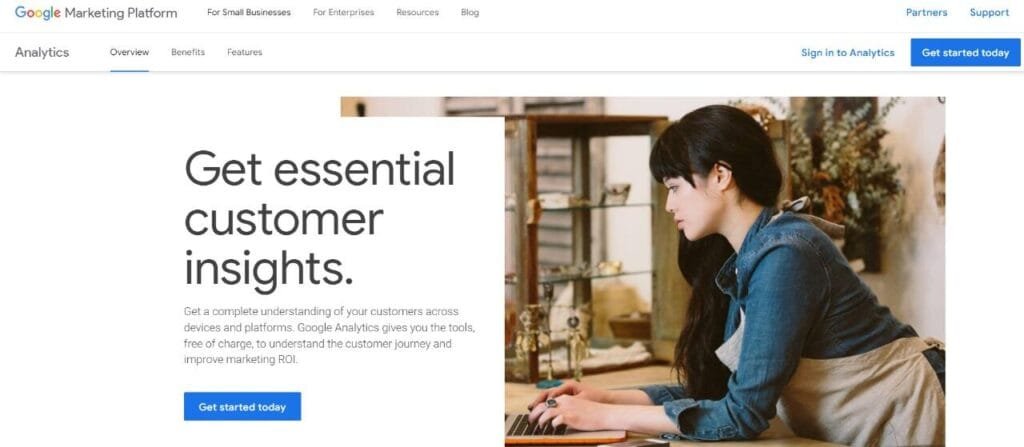
#1. Google Analytics
Google Analytics offers insights into website traffic, user demographics, user behavior, and conversion tracking. It can be particularly useful for SaaS companies when configured to track specific events like sign-ups, downloads, or trial activations.
Pros: It’s free, integrates with a host of other platforms, and offers customizable tracking options.
Cons: Can be overwhelming for beginners and requires proper setup to get the most accurate data.
Pricing: Free. A premium version, Google Analytics 360, is available for businesses with more extensive needs, priced at around $150,000 annually.

#2. Mixpanel
Beyond traditional metrics, Mixpanel allows businesses to analyze user interactions within their software, making it possible to see which features are most and least used.
Pros: Real-time data, retention analysis, and the ability to track users across multiple devices.
Cons: The learning curve for setting up and using advanced features.
Pricing: Offers a free tier. Premium plans start at $25 per month.

#3. Sisense
Sisense provides a complete data and analytics platform that enables instant insights from complex data.
Pros: Can integrate data from multiple sources and offers a drag-and-drop interface.
Cons: Might be overkill for small startups or those just looking for basic SEO analysis.
Pricing: Customized based on needs. You’d need to get a quote.
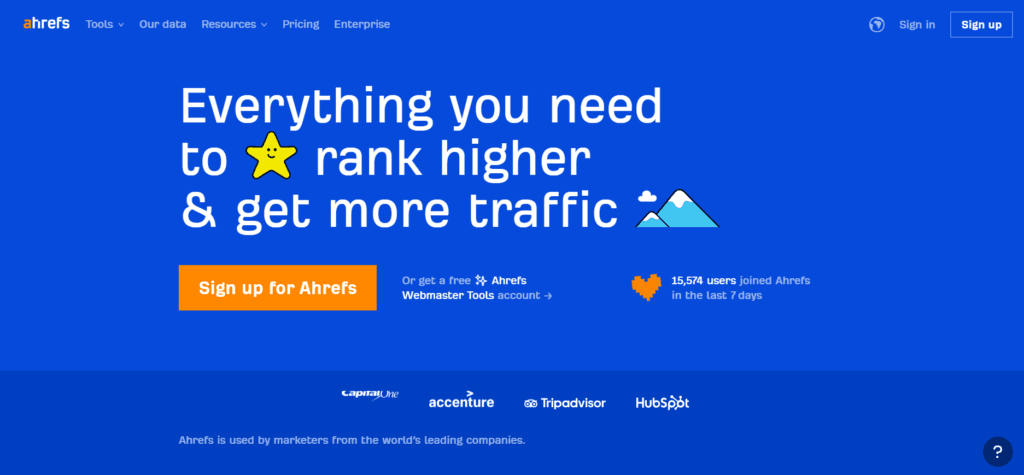
#4. Ahrefs
Known for backlink analysis, Ahrefs provides comprehensive SEO insights, from tracking rankings to spying on competitors.
Pros: Extensive backlink database, user-friendly interface, and regular updates.
Cons: Pricing might be steep for startups, and it doesn’t offer multi-language keyword tracking.
Pricing: Plans start at $99/month.

#5. SEMrush
A complete toolkit for keyword research, tracking search rankings, and checking backlinks.
Pros: Broad feature set, including competitive analysis and content audit tools.
Cons: Can be overwhelming for beginners, and some advanced features are behind higher paywalls.
Pricing: Plans begin at $119.95/month.
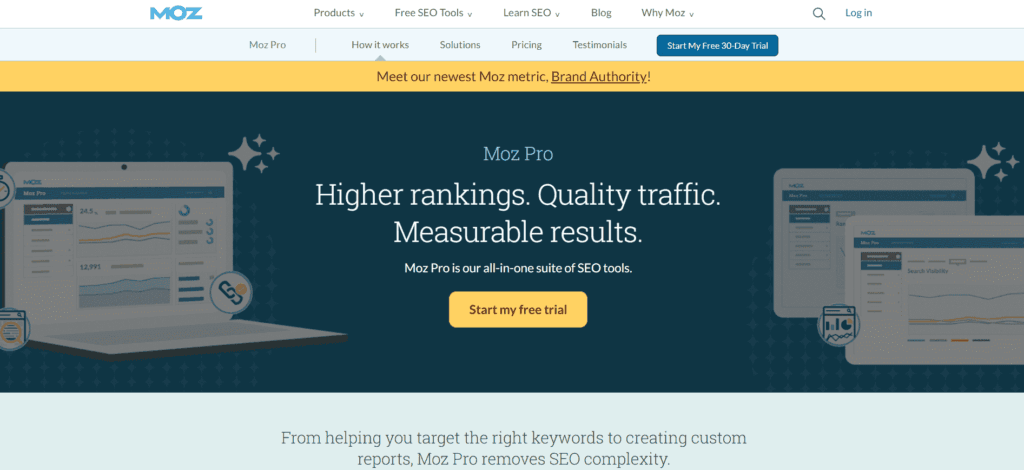
#6. Moz Pro
Moz offers a suite of tools, from keyword research to site audits and backlink analysis.
Pros: User-friendly interface, extensive keyword data, and a robust community for learning.
Cons: Some feel the data isn’t as extensive as competitors.
Pricing: Starting at $99/month.

#7. Hotjar
Provides heatmaps, session recordings, and surveys to understand how users interact with a website.
Pros: Visual insights, easy installation, and user feedback capabilities.
Cons: Limited historical data in the basic plans.
Pricing: Plans start from $99/month.
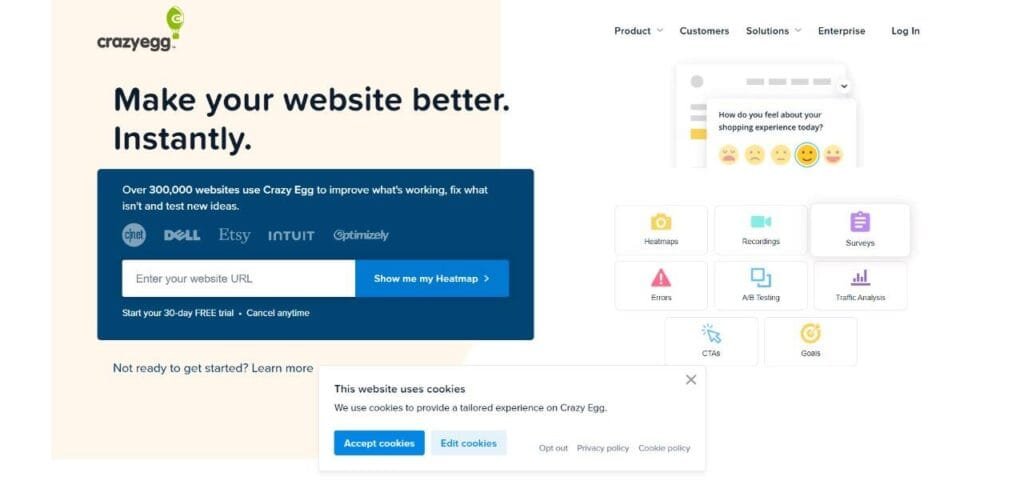
#8. Crazy Egg
Like Hotjar, Crazy Egg offers heatmaps and user session recordings.
Pros: User-friendly, A/B testing feature, and solid reporting.
Cons: Lacks advanced filtering for session recordings.
Pricing: Starting at $24/month.
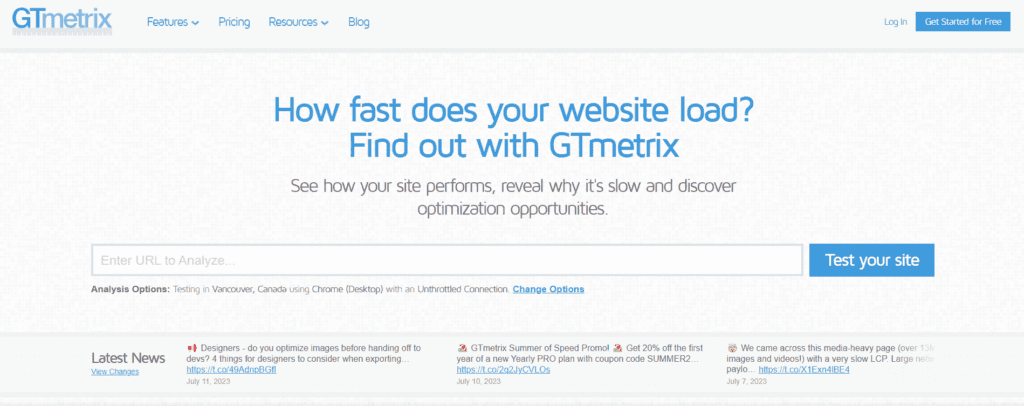
#9. GTmetrix
GTmetrix analyzes site performance and provides insights into loading issues.
Pros: Detailed performance metrics, easy to use, and offers actionable insights.
Cons: Limited to website speed analysis only.
Pricing: Free, with premium plans from $14.95/month.
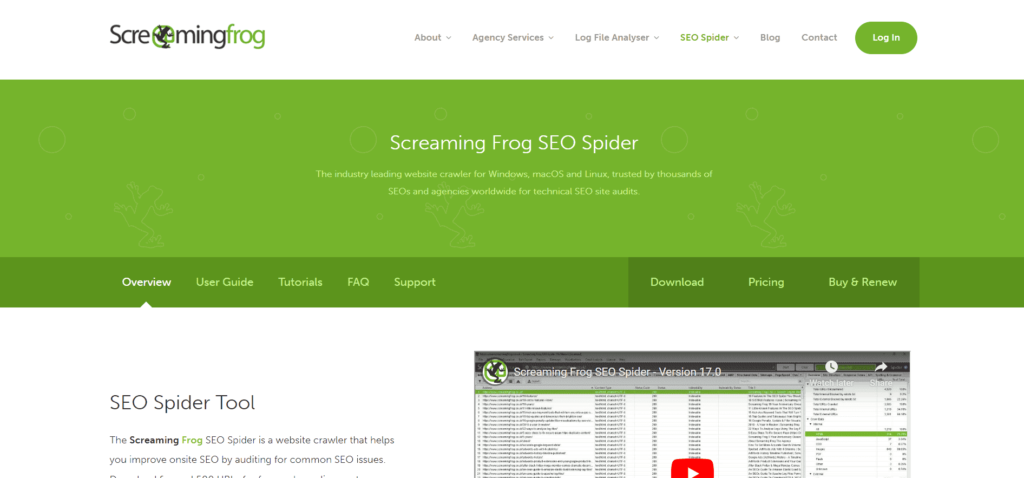
#10. Screaming Frog
Screaming Frog is one of the best SEO spider tool that crawls websites to identify SEO issues.
Pros: Comprehensive site audits, finds broken links, and analyzes page titles & metadata.
Cons: The interface is not as intuitive as cloud-based tools.
Pricing: Free version available. Paid version priced at $149/year.

#11. Ubersuggest
Ubersuggest is a cheap and relatively new SEO tool that offers quality keyword insights, backlink data, and content ideas.
Pros: User-friendly, integrates keyword suggestions with search volume and competition data.
Cons: Some limitations in backlink data when compared to other tools.
Pricing: Plans start from $29/month.
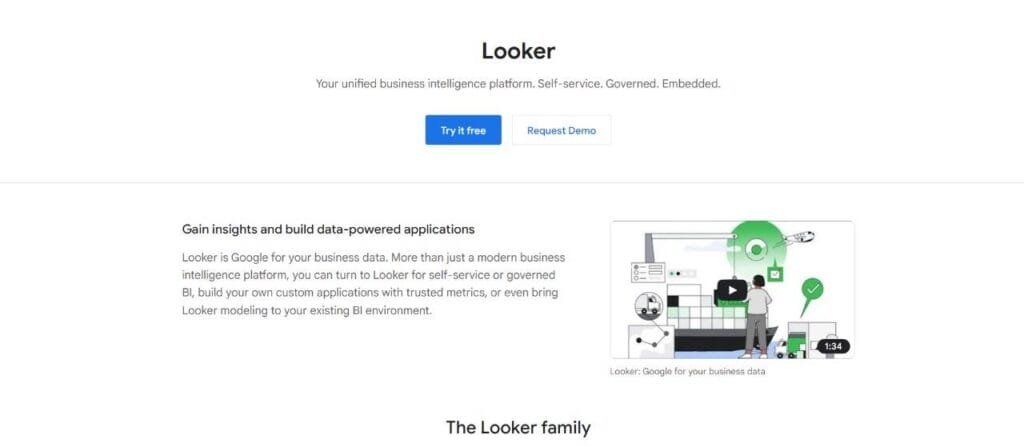
#12. Looker
Looker is a data exploration and business intelligence tool, providing insights from various data sources.
Pros: Seamless data integrations, customizable dashboards, and extensive data visualization options.
Cons: Requires SQL knowledge for advanced functionalities.
Pricing: Custom pricing based on needs.
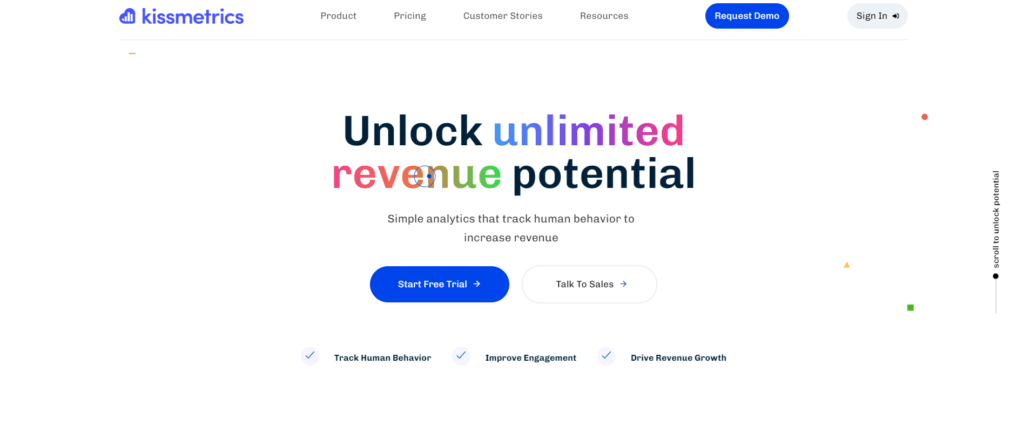
#13. KISSmetrics
KISSmetrics focuses on person-based analytics, allowing tracking of individual users across devices.
Pros: Detailed user analytics, funnel reports, and retention tracking.
Cons: Might be too advanced for smaller SaaS startups.
Pricing: Custom pricing.
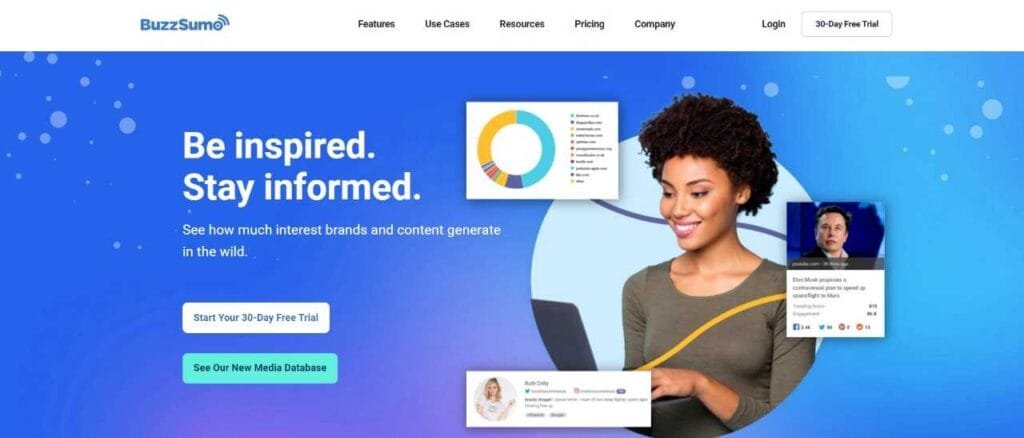
#14. BuzzSumo
BuzzSumo analyzes which content performs best for any topic, aiding content strategy.
Pros: Great for content research, influencer identification, and competitive analysis.
Cons: Limited to content analysis.
Pricing: Starting at $99/month.

#15. Woorank
Woorank provides website reviews and SEO insights to drive more traffic.
Pros: Comprehensive SEO audit tool with competitive analysis and keyword tracking.
Cons: Limited depth in backlink analysis.
Pricing: Starting from $59.99/month.

Case Study: ‘Trello’ – Decoding the Correlation between SEO and SaaS Growth
Trello, a visual collaboration tool, has experienced explosive growth in its user base. A deep dive into its growth strategies reveals a sophisticated intertwining of SEO with its product.
By tracking user interactions, Trello was able to identify organic search as a major driver for its most engaged user segments. They further leveraged this data to refine their content strategy, targeting topics and keywords that resonate with their high CLV user base.
Wrapping it up
Embarking on the SaaS journey is undoubtedly thrilling, filled with the promise of innovation and growth. However, in the cluttered digital space, standing out demands a blend of stellar product offerings and astute marketing strategies. SEO, tailored for the SaaS paradigm, can be the differentiator.
By understanding the unique user journey, targeting precise pain points through keywords, crafting compelling content, ensuring technical prowess, building credible backlinks, and focusing on local and international SEO, SaaS startups can carve a niche for themselves.
This wraps up our deep dive into SEO strategies tailored for SaaS startups. Given the complexities of both domains, marrying them effectively can seem daunting. However, with the right strategies, tools, and an unwavering focus on the user, SaaS companies can leverage SEO to scale new heights.
Read Next:
- Data Processing Agreement: An International Perspective
- Mastering Sales Intelligence: Strategies for Smarter Selling
- SaaS Agreements Explained: Tips for Successful Software as a Service Contracts
- Unlocking Psychographics-Driven Marketing: The Ultimate Guide
- HubSpot CRM Review : An In-Depth Analysis



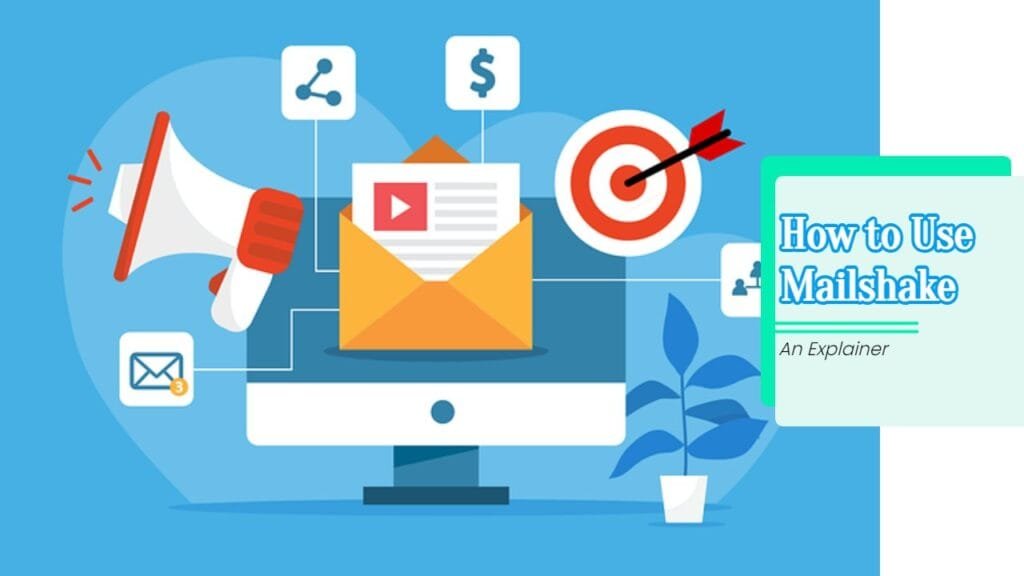















Comments are closed.